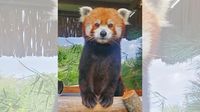Visitors to Omaha’s Henry Doorly Zoo have long been enchanted by the gentle presence of Star, the zoo’s only red panda. This week, however, the community found itself mourning after the beloved animal died peacefully on Wednesday, August 20, 2025, at the age of eight. The zoo announced Star’s passing in a heartfelt social media post on Thursday, expressing the deep sense of loss felt by staff, volunteers, and visitors alike.
Star’s story at the Henry Doorly Zoo began in 2023 when she arrived and quickly became a cherished member of the zoo family. According to reporting from KLKN and WOWT, Star was described by her animal care team as mellow, unusually attentive, and a quick learner. She was always eager for fruit treats, engaging enthusiastically in daily training sessions, especially when it came to her medical training and cooperative care skills.
“Star quickly became a cherished member of our Zoo family, and will be deeply missed by all,” the zoo wrote in its public statement, as reported by KETV. The staff’s affection for Star was echoed by zoo visitors, many of whom shared memories and condolences on social media. One regular recalled, “Just seeing her cute face climb and play was enough to make me feel warm and fuzzy. I hope she gets to keep on climbing and playing with the other stars.” Another visitor remembered her grandson’s excitement, chanting, “Red panda! Red panda! Red panda!” whenever he spotted Star.
Star’s final days were marked by a sudden health crisis. On the morning of Saturday, August 16, 2025, she began experiencing seizure activity. The zoo’s staff responded immediately, transporting her to the on-site animal hospital. Despite the dedicated efforts of the animal care and health teams, Star passed away peacefully five days later. The zoo’s statement, shared by multiple news outlets, emphasized the professionalism and compassion of its staff: “While we share our loss, we want to take a moment to acknowledge the remarkable commitment shown by our animal care and animal health teams. In challenging times, their focus never wavers—the wellbeing and dignity of the animals remain at the center of everything we do.”
Red pandas, known scientifically as Ailurus fulgens, are native to the mountainous forests of Myanmar, Nepal, India, Bhutan, and China. Their ranges overlap with those of giant pandas, though the two species are not closely related. According to the World Wildlife Fund, fewer than 10,000 red pandas remain in the wild, and almost 50 percent of their habitat is found in the eastern Himalayas. The International Union for Conservation of Nature (IUCN) lists red pandas as endangered, making each individual’s story—and loss—all the more significant.
In the wild, red pandas typically live up to 10 years, while those in captivity can reach 20 years, though the Henry Doorly Zoo notes that lifespans in human care often range from 8.5 to 10 years. Star, at eight years old, had reached a respectable age for her species, though her passing still came as a shock to those who knew her best. Her predecessor, Tofu, another red panda at the zoo, died in 2018, leaving Star as the sole representative of her species at Henry Doorly until her death.
Star’s impact on the zoo community extended far beyond her enclosure. She was described as “a beacon of joy” by her keepers, a sentiment widely shared among those who watched her move through the branches or pressed against the glass to catch her eye. Her russet coat, expressive face, and fondness for sliced fruit made her a favorite among visitors of all ages. The zoo’s social media was flooded with tributes, with one user writing, “I feel like my heart just got ripped out of my chest,” and another wishing, “I hope you have all of the treats your heart could ever desire in panda heaven.”
Star’s daily routines became a source of fascination for both staff and guests. She consistently participated in her training, demonstrating not only intelligence but also a willingness to engage with her caretakers. Her eagerness for fruit treats—especially grapes and apple wedges—became something of a signature trait. “She was always eager to see what fruit treats her caretakers had for her, demonstrating consistent engagement in her daily training and participating eagerly, particularly in her medical training and cooperative care skills,” the zoo wrote, as reported by multiple outlets including KLKN and WOWT.
For the Henry Doorly Zoo, the loss of Star is more than just the passing of an animal; it marks the end of an era. The zoo’s only red panda, she filled a unique role in both education and conservation outreach. Red pandas are a flagship species for conservation efforts worldwide, and Star’s presence helped raise awareness about the plight of her wild counterparts. The zoo’s statement reflected this ongoing mission: “Her impact on our zoo community will continue to live on, long after she has left us. She has always been and will always be a bright light in our zoo.”
The broader context of Star’s death is a reminder of the challenges facing red pandas globally. Habitat loss, poaching, and climate change continue to threaten their survival. The World Wildlife Fund’s estimate that fewer than 10,000 individuals remain in the wild underscores the urgency of conservation work. Zoos like Henry Doorly play a critical role in these efforts, both through breeding programs and by educating the public about endangered species.
For many in Omaha and beyond, Star was more than just an exhibit—she was a living connection to a distant, threatened world. Her gentle nature, intelligence, and playful spirit left an indelible mark on those who cared for her and those who visited her. As the zoo and its community grieve, they also celebrate the joy she brought and the awareness she helped foster.
Though Star’s enclosure now stands empty, her legacy endures in the hearts of those who loved her and in the ongoing work to protect her species. Her story is a poignant reminder of the fragility of life and the enduring bonds that can form between humans and animals, even across the glass of a zoo enclosure.






